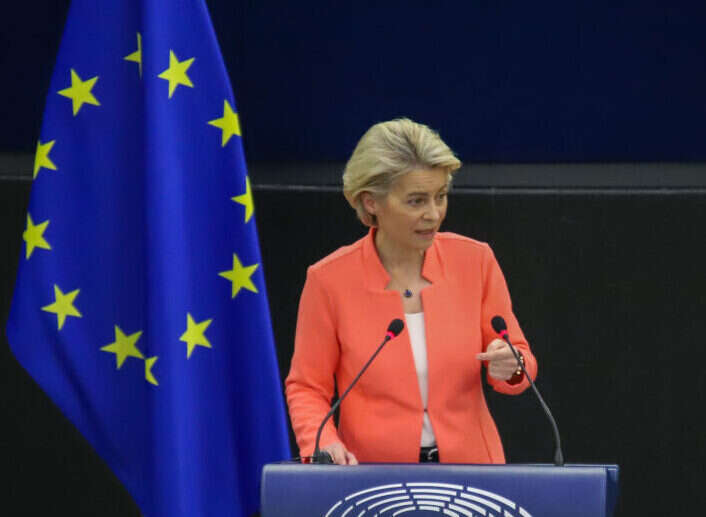
The EU has announced a new piece of legislation that will aim to boost domestic semiconductor production in order to reduce its reliance on Asian manufacturers. The “Chips Act” is intended to increase chip research, production capacity and international cooperation, and could establish a dedicated European Semiconductor Fund. But experts say that the EU’s ambitions for chip sovereignty could be misguided.

Ursula von der Leyen, president of the European Commission, wants Europe to become sovereign on semiconductors. (Photo by Valeria Mongelli/Bloomberg via Getty Images)
A global chip shortage sparked by the Covid-19 pandemic, and caused mostly by squeezed capacity at contract manufacturers including Taiwan’s TSMC, the market leader, has hit Europe’s auto industry hard – inspiring politicians to take action to increase domestic supply. In March, the EU announced its plan to increase its share of the global semiconductor market to 20% by 2030. With this in mind, the European Commission pledged $160bn of its Covid-19 recovery fund to tech projects on the continent.
The European Chips Act: why now?
The Chips Act was trumpeted by president of the European Commission Ursula von der Leyen as the latest move to strengthen the EU’s plans for “tech sovereignty”. The announcement follows the passing of the US’s Innovation and Competition Act, a $250bn bill aimed at outpacing China’s technological ambitions. Part of this bill pledges $52bn to fund semiconductor production within US borders, pouring money into research, design and manufacturing initiatives.
“Both the EU and US are reacting to their declining share of semiconductor production as Asian countries have gained ground with large government subsidies to chipmakers,” says Linley Gwennap, principal analyst at The Linley Group. “The European Chips Act is similar to the US Chips Act in creating government support to counteract these foreign subsidies.”
The EU’s announcement coincides with the opening of chipmaker Infineon’s new €1.6bn chip plant in Europe. Founder Andreas Wittmann said that although the company wouldn’t have set up a European chip plant 20 years ago, “the increase in automation has decreased the advantage of Asia”. The new plant, which will primarily make semiconductors for cars, requires around ten people on the factory floor, compared to around 140 for older facilities.
But the EU’s insistence on increasing domestic chip supply is seen by some as overly reactive to a problem that won’t necessarily persist in the long term. “The current shortage of semiconductors is induced by the economic coma that followed the Covid-19 surge: chip production shifted from unsold cars to highly desired home appliances and computers,” says Bob Hancké, associate professor in political economy at the London School of Economics. “In the medium run, therefore, chips will become available and cheaper again.”
Infineon said it received some subsidies to set up the new factory, and the EU’s plans to tempt chipmakers to set up plants seem to be working to some extent. Intel announced in September that it would invest up to $95bn in European chip-making facilities, despite Intel CEO Pat Gelsinger previously saying that it would take subsidies worth more than $8bn to convince the company to open a new European chip foundry.
TMSC also appears to have warmed to Europe. In March, TSMC’s chairman Mark Liu dismissed the EU’s semiconductor ambitions as “unrealistic” and it was reported that the company would look to double down on its US production capacity instead. But Liu told shareholders at the company’s annual general meeting in July that the company was now considering building its first European semiconductor plant in Germany.
“With a more level playing field, I would expect even Asia-based chipmakers such as Samsung and TSMC to consider building fabs in Europe,” says Gwennap.
How can Europe grow its domestic chip supply?
The EU’s options for increasing domestic chip supply include boosting its homegrown chip-makers Infineon, Bosch and STMicroelectronics; doubling down on the elements of chip making it already does well including R&D and highly specialised high-tech manufacturing, like that carried out by Dutch company ASML, the world’s only supplier of advanced lithography machines used in semiconductor manufacturing.
Another option is to try and tempt more major global chipmakers, like Intel and TSMC, to set up plants in Europe, but this may not solve the EU’s problems. Infineon CEO Reinhard Ploss said earlier this year that if financial incentives are used to tempt international chipmakers to build EU-based plans, their biggest customers would remain foreign tech giants, rather than European companies.
The scale of funding required, and whether the EU is able to provide it, is another issue. The EU has yet to signpost any specific amount of cash for chip production, but at least €20bn in subsidies is needed to boost EU semiconductor production in line with Asia and the US, chief executive of one of France’s leading suppliers of semiconductor materials Soitec, Paul Boudre, said last week.
We don’t believe that any amount of money would make EU technologically sovereign.
Risto Puhakka, VLSIresearch
Others say this amount would fall far short of what is required. “We don’t believe that any amount of money would make EU technologically sovereign,” says Risto Puhakka, president of VLSIresearch. “We estimated a few years ago for China to become a fourth-equal semiconductor manufacturing region (equal to US, Korea and Taiwan), would cost approximately $500bn over ten years. The price tag is now higher.”
Another issue is wage costs in Europe, where salaries are comparatively higher than the Asian companies that currently dominate the global semiconductor supply chain. Despite Infineon’s new, sparsely-staffed Austrian fab, the labour-intensive, back end process for its semiconductors (where wage costs play a more important role), will still take place in Infineon’s finishing plant in Malaysia.
The “imbalance between extremely high up-front cost and relatively meagre financial reward is at the heart of the problem: production of chips for mass markets…really only makes sense in low-wage countries as a result,” Hancke concludes.






